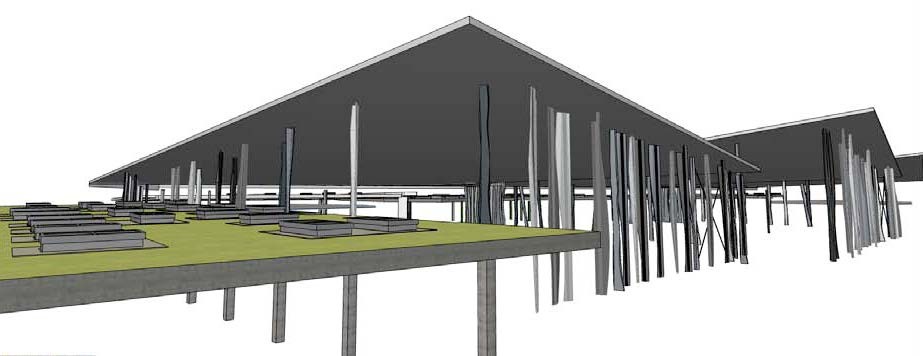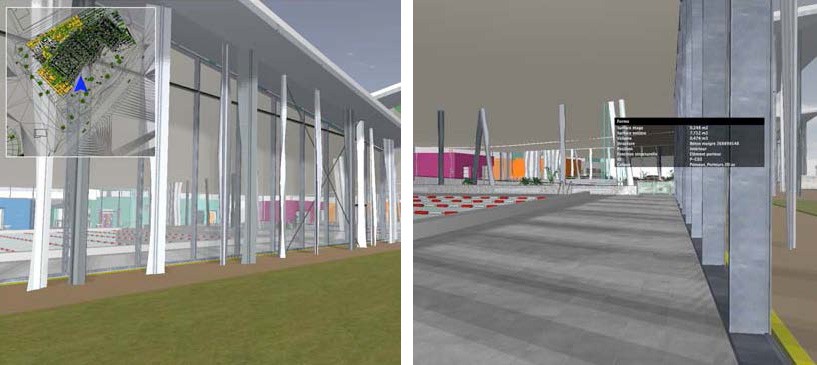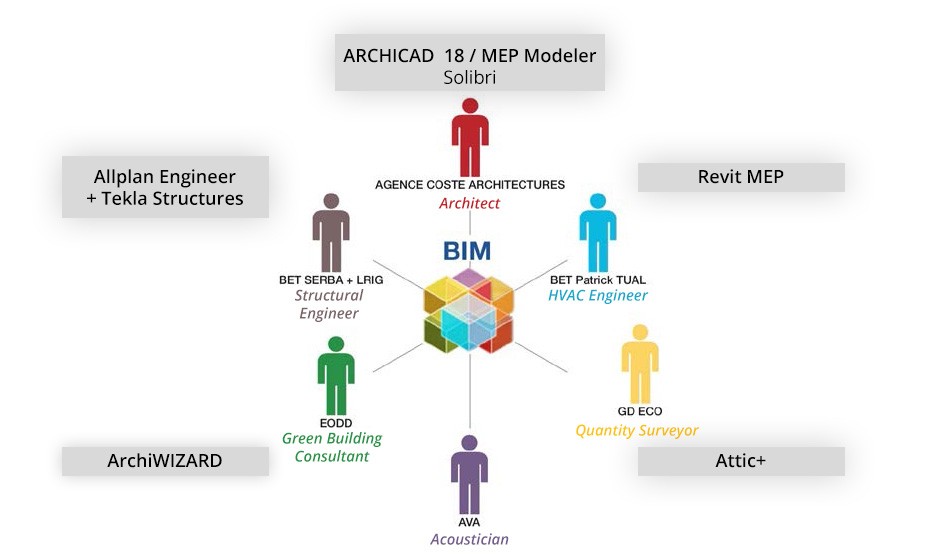Saint-Nazaire Aquatic Center
In July 2013, CARENE, a Saint-Nazaire developer, chose Coste Architecture’s design of their Aquatic Center. Apart from their thorough compliance with the program, their energy and environmental proposals, and their architectural proposal – 3 wavy roofs supported by poles – the Coste Agency demonstrated innovations: technical innovations, first of all, with their structural columns in seismic zones, as well as innovations in their project management with the use of BIM.
The following year, Coste Architectures won the first BIM d’Or award, a French competition rewarding exemplary uses of BIM in a collaborative process gathering Architects, Engineers, Contractors and Project clients. Emmanuel Coste received this award from the hands of the 2014 jury led by Bertrand Delcambre, the head of the French national Building Digital Transition Plan (PTNB). This year, Coste was appointed as the president of the jury of the 2015 competition.
At the end of 2014, after the design development phase, Coste Agency prepared the construction documentation and sent queries to contractor companies (start of work in June 2015 for delivery in March 2017). In early 2015, Emmanuel Coste, director architect of the agency, and Sam Cordier, their BIM Manager, summed up their use of BIM with Archicad in the study and design phase with a realistic and practical point of view.

Use of BIM
in the competition
Since the competition, the developer represented a virtuous approach by asking for, apart from an overall construction budget, an additional budget for clean energy initiatives from each of the candidates. In addition to their architectural and energy proposal, the use of BIM proposed by the Coste Agency was quickly perceived as “the icing on the cake.” The developer instantly saw the benefits of such an approach:
- Short-term: 3D Visualization and Virtual Tour – particularly useful for both consultation and communication.
- Mid-term: Minimizing error risks and extra costs during construction.
- Long-term: Building operation and maintenance; Carene decided to train its teams internally on BIM.
“Not only does BIM assure seamless coordination between all stakeholders, but it also leads to positive results of this collaborative work”
Emmanuel Coste, Architect
For Coste Architectures, a pioneer in the use of CAD tools, BIM is the obvious choice: a proven working method. BIM is primarily a way to meet all the challenges that their architectural proposal presented. An aquatic center – let alone with 1200m2 of pools and high environmental quality energy requirements – requires close collaboration with water and energy experts. An architectural proposal of three roofs in the form of waves, supported by structural laminaria shaped columns in a seismic zone calls for true collaboration with structural engineers specializing in Ultra High Performance Fiber Concrete.
Presenting this 3D model developed in Archicad reveals further assets: immersive virtual presentations with BIMx; internal animations made simple and fast with Artlantis; and easy export of the model for the CGI artist, whatever his software might be. Working closely with real partners, detecting problems as early as possible in the project, thus avoiding most risks of error and surprises: these are the benefits of BIM used in the design phase. “Not only does BIM assure seamless coordination between all stakeholders, but it also leads to positive results of this collaborative work,” explains Emmanuel Coste. “From now on, decisions can be made from as early as the preliminary design phase – a valuable time saver for the future course of the project.”
“IFC Management in Archicad is truly successful – quite frankly — the best. ”
Emmanuel Coste, Architect

IFC – OPEN BIM
But more specifically, how is this little acronym after so many challenges? Sam Cordier, BIM Manager at Coste Architectures sums up the basics: “BIM is a 3D model of a building where each entity is described in a common language – IFC– understandable by all stakeholders. The advantage is that when we communicate with partners, we always talk about the same thing without ambiguity, without additional semantics.
“IFC Management in Archicad is truly successful – quite frankly – the best. It follows the product philosophy: Archicad has, from the beginning, been object-oriented and open to all formats. When we model with Archicad, the created entity is not simple form, it is an object “that has the intelligence – so to speak – to not be just a single entity in the database, but have a justified place in the context. For example, if you model 4 walls and you tilt one, the other walls will automatically follow.” Archicad has always attributed parameters and information to modeled objects; IFC also adds to these attributes, in the same automatic manner.
“If we create a wall, BIM information is automatically assigned to it: a GUID and an IFC category: Wall / standard. This may at first seem “barbaric,” but that just means that the created object has a unique identity for the entire life cycle of the building and it is an object belonging to the category “wall.” Many people think IFC is complicated and one must constantly adjust settings. But in Archicad, many procedures are pre-wired and seamless to the user.”
For more specific procedures, “such as the creation of a Column with the Slab Tool, simply disengage the IFC class, and replace the IFC:slab with IFC:column. In Archicad, it’s very easy to do.

Automation does not impair flexibility. You are never forced to use one modeling tool to attain a certain IFC architectural category.” If IFC Management in Archicad is flexible and transparent for the architect, this flexibility is also reflected in the exchange with partners. Archicad is committed to OPEN BIM and, therefore, requires no additional software in order to exchange Archicad models with engineers through IFC.
For the specific example of the Aquatic Center of Saint-Nazaire, the agency and their BIM Manager chose to deal with three batches of IFC in Archicad: the main structure, the frame, and the MEP network. According to the partners, the exchange of the digital model created in Archicad worked equally well with Revit MEP, Tekla Structures, AllPlan, and Solibri.
Here are the exchanges between the software of different stakeholders:
- Archicad ⇄ AllPlan Engineering (Infrastructure Engineers)
- Archicad MEP Modeler ⇄ Revit MEP (HVAC / MEP Engineers)
- Archicad ⇄ Tekla Structures (Metal Structure Engineers)
- Archicad ⇄ ATTIC + (Quantity take-off for Quantity surveyor)
- Visualization & Model Checking: Solibri Model Checker
- Visualization & Model Checking: Tekla BIM Sight

“The structural part was the easiest to handle. As general architects, we supplied nothing but the shape of the roof in IFC. Serba, the structural engineers, worked on this model in Tekla Structure – also a certified OPEN BIM software – and sent it back to us with all the frame elements automatically in place.
“We had several iterations, since this is a collaborative process. It’s an exchange, and if we have a problem, we talk about it and look for a solution based on everyone’s expertise and discipline.”
“Regarding the MEP deliverables, I primed the pump – so to speak – reassuring the MEP engineer, because he was not used to this method of work. So I started building the MEP system in Archicad’s MEP Modeler add-on. This module does not allow calculations, but I am not an engineer; this is indeed the work of the engineering office. But MEP Modeler allowed me to model the network elements, identify them as such using IFC classes, and, therefore, be recognized by the engineer’s MEP software as MEP elements. So after introducing the elements in the Archicad model, Tual, the engineer could claim them in Revit MEP. He used his software to further work on the project, which we could then easily reinsert in the Archicad model.

Further application of BIM
Convinced by the successful integration of BIM in the early stages of the Aquatic Centre in Saint-Nazaire, the developer intends to continue its use for subsequent phases of the project: Business Consulting, Synthesis and job tracking, Maintenance and operation … so many “craft” benefits will follow, as and when the project progresses.
Interviewed by Abvent, Graphisoft Partner since 1985 and exclusive Archicad distributor for France, Switzerland and Frenchspeaking Africa.

About Coste Architectures
Emmanuel Coste directs Coste Architectures since 1997, a company founded in the eighties by his father, the architect François Coste in Montpellier.
In association with Renaud Delplanque and André Ariotti, Emmanuel Coste and his team (16 architects and a network of 25 specialists integrated to the company as well as independent partners: set designers, landscapers, ergonomists, artistic directors, design and engineering offices etc…) ensure the reliability and creative capacities of a company enriched by its 30 years of experience.
In addition to its main practice in Paris region and the office in Montpellier, Coste Architectures has opened two new subsidiairies in China and Algiers.

About Graphisoft
Graphisoft® ignited the BIM revolution in 1984 with Archicad®, the industry first BIM software for architects. Graphisoft continues to lead the industry with innovative solutions such as its revolutionary BIMcloud®, the world’s first real-time BIM collaboration environment; and BIMx®, the world’s leading mobile app for lightweight access to BIM for non-professionals. Graphisoft is part of the Nemetschek Group.
